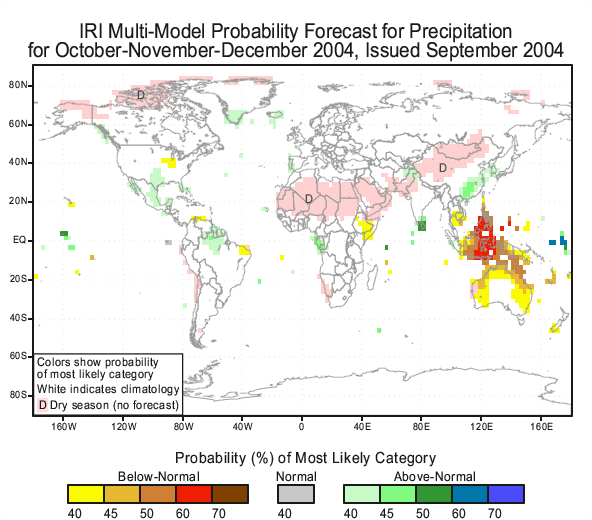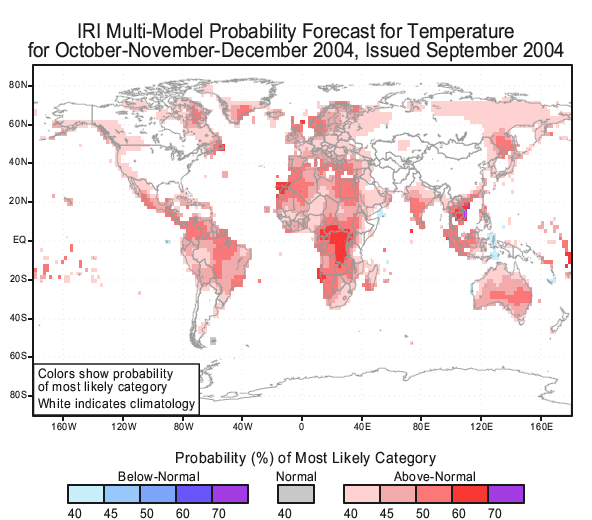|
IRI Climate Digest
September 2004
October-November-December Seasonal Forecast
Date and Period of Forecast
In September 2004, the IRI prepared a Climate Outlook for October 2004-March 2005. Here we provide a subset of the September IRI Forecast. The forecasts are updated monthly and can be found in their entirety at http://iri.columbia.edu/climate/forecast/net_asmt/.
Uncertainties
This Climate Outlook is dependent on the quality of the sea surface temperature (SST) predictions. For the tropical Pacific, these predictions can be expected to provide useful information, but there is some uncertainty concerning the detailed evolution of SSTs. Spread in global SST predictions is a source of uncertainty in the Outlook provided here. The procedures, models, and data used to derive this Climate Outlook may be somewhat different from those used by National Meteorological Services in particular regions and may differ from the official forecasts issued in those areas.
Regional Influences
The current status of seasonal-to-interannual climate forecasting allows prediction of spatial and temporal averages, and does not fully account for all factors that influence regional and national climate variability. This Outlook is relevant only to seasonal time scales and relatively large areas; local variations should be expected. For further information concerning this and other guidance products, users are strongly advised to contact their National Meteorological Services.
Precipitation Outlook
The Outlook for other regions of the globe for the seasons October-November-December through January-February-March can be found at Net Assessment forecasts.
Maps show expected precipitation probabilities in tercile classes. The maps indicate probabilities that seasonal precipitation will fall into the wettest third of the years (top number), the middle third of years (middle number) or the driest third of the years (bottom). An outlook of climatology "C" (no color) indicates equal probabilities in each class; i.e., there is no basis for favoring the forecast of any particular category. Boundaries between sub-regions should be considered transition zones, and their location considered to be only qualitatively correct. Color shading indicates which tercile class has the greatest probability of occurrence with darker shading indicating greater likelihood as shown by the legend to the right of the plots.
October-November-December 2004 Global Precipitation Probabilities

Temperature Outlook
This forecast consists of expected probabilities of temperature in tercile classes. The terciles refer to the seasonal temperature falling into the warmest third of the years (top tercile), the middle third of years (middle tercile) or the coldest third of the years (bottom tercile). Boundaries between sub-regions should be considered transition zones, and their location considered to be only qualitatively correct. Color shading indicates which tercile class has the greatest probability of occurrence with darker shading indicating greater likelihood as shown by the legend on the bottom of the plots. Note:
The IRI is in the process of implementing new graphics for its forecast products. Currently, global maps only indicate (by shading) the tercile class with the greatest probability of occurrence.
Please consult the regional maps at Net Assessment forecasts for the probabilities of each tercile class.
October-November-December 2004 Global Temperature Probabilities

Ocean Conditions
Of relevance in the preparation of this outlook is a likelihood that weak El Niņo conditions will occur during the four forecast periods. Such ENSO conditions are indicated in the SST predictions on which these climate forecasts are based. See the IRI's ENSO update for a discussion on the ENSO outlook (see IRI Probabilistic ENSO forecast). Warmer than average SSTs now prevail in the east-central, central and west-central tropical Pacific, while cooler than average SSTs exist in the eastern quarter of the tropical Pacific and in the vicinity of the Maritime Continent. Much of the area of the Indian Ocean and the north tropical Atlantic Ocean continue to show above-average SSTs (SSTs). These are predicted to continue, but gradually weaken, during the forecast period (October-December 2004, November-January 2005, December-February 2005, January-March 2005).
Methods
The following procedures and information were used to prepare this Climate
Outlook:
- Coupled ocean-atmosphere model predictions of tropical Pacific SST
-- particularly heavy weighting has been given to the NOAA /NCEP,
Climate Modeling Branch coupled model
- Statistical forecasts of Indian Ocean and Atlantic Ocean sea surface
temperature
- The response of Atmospheric global circulation model (GCM) predictions
to the present and predicted SST patterns
- Statistical analyses
- Appropriate Regional Climate Outlook Forum consensus guidance.
|
Additional sources of information include ACMAD, COLA, CPTEC, CPC/NOAA,
CMC, Department of Natural Resources (Queensland, Australia), NIWA, ECMWF,
Indian Meteorological Department, PAGASA, Bureau of Meteorology, and the
South African Weather Service.
|
Contents |
Special |
Impacts |
Climate |
Forecast
|

